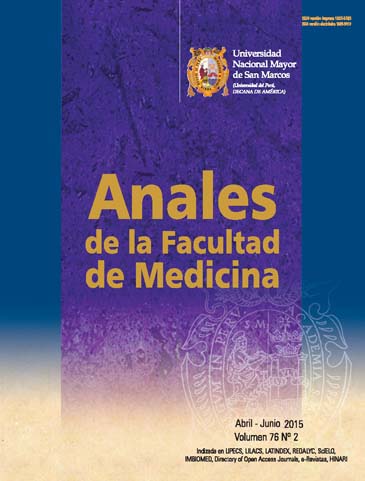Evaluation of an instrument to quantify stigmatization of pregnant adolescent in Peru.
DOI:
https://doi.org/10.15381/anales.v76i2.11140Keywords:
Adolescent, questionnaires, pregnancy, validation study, stigmatization.Abstract
Introduction: Teenage pregnancy is a public health problem that places the status of a teenager in biomedical and social vulnerability, the stigmatization of a pregnant adolescent. Objective: To evaluate psychometrically an instrument to measure stigmatization of pregnant adolescents. Design: Cross-sectional study. Location: National Maternal Perinatal Institute, Lima, Peru. Participants: Adolescent puerperae. Interventions: To 292 postpartum adolescents attended from January through May 2010 an Adolescent Pregnant Stigma Scale (APSS) consisting in 7 items was applied. For the theoretical construction of the scale, two promoter entities of social stigma were assumed: family and social environment. To assess the predictability of APSS the following hypothesis was considered: the higher levels of stigma are associated with a lower self-concept of the adolescent mother. Main outcome measures: Cronbach's alpha coefficient, medians, T student. Results: The psychometric analysis revealed for APSS a Cronbach's alpha coefficient of 0.78; two dimensions accounted for 65.8% of the total variance. Conclusions: The hypothesis was verified: a lower self-concept of the adolescent as a mother was significantly associated with higher scores of APSS (p <0.05). APSS had high consistency. There was also an association with a lower maternal self-concept, making the scale reliable and valid for use in pregnant adolescents.Downloads
Published
2015-06-15
Issue
Section
Artículo Original
License
Copyright (c) 2015 Elizabeth Mori Quispe, Hans Contreras Pulache, Willy David Hinostroza Camposano, Nelly Lam Figueroa, Oscar Huapaya Huertas, Horacio Chacon Torrico, Carolina Black Tam, Debora Urrutia Aliano

This work is licensed under a Creative Commons Attribution-NonCommercial-ShareAlike 4.0 International License.
Those authors who have publications with this magazine accept the following terms:
- Authors will retain their copyrights and guarantee the journal the right of first publication of their work, which will be simultaneously subject to Creative Commons Attribution License that allows third parties to share the work as long as its author and its first publication this magazine are indicated.
- Authors may adopt other non-exclusive licensing agreements for the distribution of the version of the published work (eg, deposit it in an institutional electronic file or publish it in a monographic volume) provided that the initial publication in this magazine is indicated.
- Authors are allowed and recommended to disseminate their work over the Internet (eg: in institutional telematic archives or on their website) before and during the submission process, which It can produce interesting exchanges and increase quotes from the published work. (See El efecto del acceso abierto ).
How to Cite
1.
Mori Quispe E, Contreras Pulache H, Hinostroza Camposano WD, Lam Figueroa N, Huapaya Huertas O, Chacon Torrico H, et al. Evaluation of an instrument to quantify stigmatization of pregnant adolescent in Peru. An Fac med [Internet]. 2015 Jun. 15 [cited 2025 Jun. 6];76(2):141-6. Available from: https://revistasinvestigacion.unmsm.edu.pe/index.php/anales/article/view/11140



